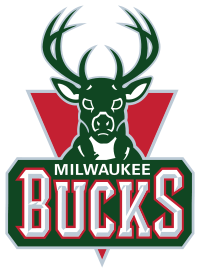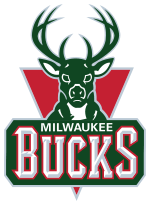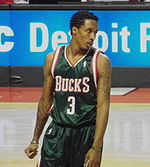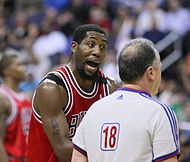- Milwaukee Bucks
-
Milwaukee Bucks  2011–12 Milwaukee Bucks season
2011–12 Milwaukee Bucks seasonConference Eastern Conference Division Central Division Founded 1968 History Milwaukee Bucks
(1968–present)Arena Bradley Center City Milwaukee, Wisconsin Team colors Hunter Green, Natural Red, Silver, White
Owner(s) Herb Kohl General manager John Hammond Head coach Scott Skiles D-League affiliate Fort Wayne Mad Ants Championships 1 (1971) Conference titles 2 (1971, 1974) Division titles 13 (1971, 1972, 1973, 1974, 1976, 1980, 1981, 1982, 1983, 1984, 1985, 1986, 2001) Retired numbers 7 1, 2, 4, 14, 16, 32, 33 Official website bucks.com The Milwaukee Bucks are a professional basketball team based in Milwaukee, Wisconsin, United States. They are part of the Central Division of the Eastern Conference in the National Basketball Association (NBA). The team was founded in 1968 as an expansion team, and currently plays at the Bradley Center. U.S. Senator Herb Kohl is the owner of the team, with Scott Skiles as head coach and John Hammond as general manager. The Bucks have won one league title (1971), two conference titles (1971, 1974), and thirteen division titles (1971, 1972, 1973, 1974, 1976, 1980, 1981, 1982, 1983, 1984, 1985, 1986, 2001). They have featured such notable players as Kareem Abdul-Jabbar, Oscar Robertson, Bob Lanier, Ray Allen, and Michael Redd.
Franchise history
Formation and the arrival of Lew Alcindor (Kareem Abdul-Jabbar)
The Milwaukee Bucks were formed in January 1968 when the NBA awarded a franchise to Milwaukee Professional Sports and Services, Inc. (Milwaukee Pro), a group headed by Wesley Pavalon and Marvin Fishman. In October, the Bucks played their first NBA regular season game against the Chicago Bulls before a Milwaukee Arena crowd of 8,467. As is typical with expansion teams, the Bucks' first season, 1968–69, was a struggle. Their first victory came in their 6th game as the Bucks beat the Detroit Pistons 134–118; they would win only 26 more games in their first year. The Bucks' record that year earned them a coin flip against their expansion brethren, the Phoenix Suns, to see who would get the first pick in the upcoming draft. It was a foregone conclusion that the first pick in the draft would be Lew Alcindor of UCLA. The Bucks won the coin flip, but had to win a bidding war with the upstart American Basketball Association to secure him.
1969-1975: Kareem Abdul-Jabbar and Oscar Robertson era
While it was expected that Alcindor would make the Bucks respectable almost overnight, no one expected what happened in 1969–70. They finished with a 56–26 record—a nearly exact reversal of the previous record. This was good enough for the second-best record in the league, behind the New York Knicks. The 29-game improvement was by far the best in league history—a record which would stand for 10 years until the Boston Celtics jumped from 29 wins in 1978–79 to 61 in 1979–80 (the difference again being a highly-touted rookie, Larry Bird). The Bucks defeated the Philadelphia 76ers in five games in the Eastern semifinals, only to be dispatched in five by the Knicks in the Eastern finals. Alcindor was a runaway selection for NBA Rookie of the Year.
The following season, the Bucks got an unexpected gift when they acquired Oscar Robertson, known as "the Big O", in a trade with the Cincinnati Royals. Subsequently, in only their third season the Bucks finished 66–16—the second-most wins in NBA history at the time, and still the most in franchise history. During the regular season, the Bucks recorded a then-NBA record 20 game win streak. They then steamrolled through the playoffs with a dominating 12–2 record, winning the NBA Championship on April 30, 1971 by sweeping the Baltimore Bullets in four games. By winning it all in only their third season, the Bucks became the fastest expansion team in NBA history to win the championship, however four decades later, it remains the only title in club history.
The Bucks remained a powerhouse for the first half of the 1970s. In 1972, they recorded their third consecutive 60-win season, the first NBA team to do so. During the year, Lew Alcindor converted to Islam and changed his name to Kareem Abdul-Jabbar. Milwaukee beat the Warriors in the playoffs 4-1, but lost the conference finals to Los Angeles 4-2. Injuries resulted in an early 1973 playoff exit, but the Bucks were back in the 1974 NBA Finals against the Boston Celtics. In Game 6 of the series, Jabbar made a patented "sky hook" shot to end a classic double-overtime victory for the Bucks. The Bucks lost Game 7 and the series to the Celtics; as of 2010, they have not returned to the NBA Finals. As the 1974-1975 season began, Abdul-Jabbar suffered a hand injury and the team got off to a 3-13 start. After his return, other injuries befell Milwaukee, sending them to the bottom of their division with 38 wins and 44 losses. When the season ended, Abdul-Jabbar made the stunning announcement that he no longer wished to play for the Bucks, stating that he needed the big city. He thus requested a trade to either Los Angeles or New York. The front office was unable to convince him otherwise and on June 16, 1975, the Bucks pulled a mega-trade by sending Jabbar to the Lakers for Elmore Smith, Junior Bridgeman, Brian Winters and David Meyers. The trade triggered a series of events that led to a change in the team's ownership. Jim Fitzgerald, the Bucks largest stockholder, opposed the trade and wanted to sell his stock. Although Fitzgerald was the largest stockholder, he didn't own enough stock to control the team.
1976-1987: Don Nelson era
After the mega-deal, the Bucks had several seasons in transition, but most of these players would bear fruit. After being sold to cable television executive Jim Fitzgerald and several partners in 1976, the Bucks would enter into another era of greatness. It began with Don Nelson who became head coach in November 1976 after Larry Costello abruptly resigned. In the 1977 draft, the Bucks had three first round picks and drafted Kent Benson, Marques Johnson and Ernie Grunfeld. Johnson would become a staple in the Bucks for years to come. Rookie Sidney Moncrief made his debut in 1979.
On Oct 18, 1977, Jabbar, playing with L.A., punched Benson during a game. Jabbar broke his hand in the process.[1] Benson had been aggressive under the boards and Jabbar, a martial arts blackbelt, snapped. Jabbar was fined $5,000 by the NBA and missed the next 20 games. Meanwhile, Benson never played as aggressively again. In February 1980, the Bucks traded Kent Benson to Detroit for veteran center Bob Lanier to fill in the hole left by the departure of Jabbar. They then won the Midwest Division title in 1980. After losing to Seattle in the semi-finals, the Bucks moved to the Eastern Conference's Central Division.
There, they would win 6 straight division titles and have .500 seasons for the next 11 years. Within those years, the Bucks became perennial Eastern Conference contenders, primarily due to the strong play of Moncrief, Paul Pressey, Craig Hodges and the arrival of Terry Cummings, Ricky Pierce and Jack Sikma from trades with the Los Angeles Clippers and Seattle respectively. However, the Bucks were unable to make it to the NBA Finals again, being eliminated by either the Celtics or the Sixers each time.
For much of the 1970s the Bucks colors were forest green, deep red and white. In 1978, they added various shades of green to the uniforms, and in 1985, they eliminated red from the team colors.
Ownership and arena changes
In 1985, Fitzgerald and his partners(one of which was Stuart Shadel) decided to sell the Bucks. He was having health problems and some of his investors wanted to get out. The Bucks were playing in the smallest arena in the NBA and the city didn't want to build a new one. Milwaukee businessman (and now U.S. Senator) Herb Kohl bought the Bucks after fears that out-of-town investors could buy the team and move it out of Milwaukee. Before the transaction was complete, Jane and Lloyd Pettit of Milwaukee announced they were donating a new arena called the Bradley Center. In 2003, after considering selling the team, Kohl announced that he had decided against selling the Bucks to Michael Jordan and would "continue to own them, improve them and commit them to remaining in Wisconsin."
1990–1998: Rebuilding
For most of the 1990s, the Bucks franchise was mired in mediocrity under coaches Frank Hamblen, Mike Dunleavy, and Chris Ford. From 1991 through 1998, the Bucks suffered seven straight seasons of losing records. During this period, the Bucks drafted Glenn Robinson with the first overall pick in the 1994 NBA draft and in 1996 acquired rookie Ray Allen in a draft day trade with the Minnesota Timberwolves. Both players would have prominent roles in the Bucks resurgence during the late 1990s.
To honor the franchise's 25th Anniversary in 1993, the Bucks overhauled their logo and uniforms. The old logo, which featured a cartoonish deer, was replaced in favor of a more regal one. The primary color scheme was altered as well, when red was supplanted by purple. Purple road uniforms replaced the former green away uniforms.
1998–2003: George Karl era
After a decade of dwelling near the bottom of the NBA's standings, the Bucks looked to add credibility to their basketball operations. In 1998, the team hired veteran coach George Karl, who had reached the NBA Finals with the Seattle SuperSonics. Under the leadership of Karl and general manager Ernie Grunfeld, and with the steady addition of talent such as Tim Thomas and Sam Cassell, the Bucks developed into an elite team in the Eastern Conference. The nucleus of "the big three"-- consisting Allen, Cassell, and Robinson-- along with Karl, created a successful renaissance era in Milwaukee. The team reached its zenith in 2000-2001, winning 52 games and the Central Division title. That year the Bucks reached the 2001 Eastern Conference Finals, which they lost in seven games to the Philadelphia 76ers.
After coming painstakingly close to a championship appearance in 2001, the Bucks sought to make key offseason personnel additions to put the team in the NBA Finals. Behind the strong encouragement of George Karl, the Bucks acquired forward Anthony Mason at the beginning of the 2001–02 season. On paper, this made the Bucks the team to beat in the Eastern Conference. On and off the court, however, team chemistry was destroyed by the presence of Mason. The Bucks, who at the season's midway point were the number four seed in the Eastern Conference, began an unthinkable free-fall. The collapse culminated with a loss to the Detroit Pistons on the final night of the season, eliminating the Bucks from playoff contention. The fallout created tension between the team's three stars and coach, resulting in the trade of Glenn Robinson to Atlanta (for Toni Kukoc and a 2003 first-round draft pick, used to select T. J. Ford).
During the 2002–03 season, the Bucks traded superstar guard Ray Allen and backup Ronald "Flip" Murray to the Seattle SuperSonics for Gary Payton and Desmond Mason. The trade allowed emerging star Michael Redd to see increased playing time, and with Gary Payton in the backcourt, the Bucks finished the season with a 42–40 record. The Bucks made the playoffs but lost in the first round to the New Jersey Nets in six games. That offseason, team leaders Sam Cassell and center Ervin Johnson were traded to Minnesota (for Joe Smith). Payton left via free agency, after playing only 28 games for the Bucks. Coach George Karl's tenure in Milwaukee also ended after the season. Within a one-year period, the team had lost the coach and "big three" players most responsible for the team's success during that era.
2003–2008: Playoff and regular season failures
Under the direction of new general manager Larry Harris, The Bucks struggled with inconsistency and injury for the next six years. During this period they reached the playoffs twice, first under coach Terry Porter in 2004 and then Terry Stotts in 2006. In both instances they were defeated by the Detroit Pistons in five games. During this period, Michael Redd blossomed into an All-Star and a perimeter shooting threat, becoming the new "face of the franchise." The Bucks received the No. 1 pick in the 2005 NBA Draft, and used it to select center Andrew Bogut. Bogut struggled with both inconsistency and injuries in his first four years in Milwaukee, but over time become a key contributor to the Bucks.
In March 2008, the Bucks' fans selected the franchise's 40th Anniversary Team, which included notable players like Kareem Abdul Jabbar, Oscar Robertson, Ray Allen, Sidney Moncrief, and Michael Redd, to name a few.[2]
On March 20, 2008, the Bucks announced that they would not renew general manager Larry Harris's contract, which was to expire June 30, 2008. On April 11, 2008, the Bucks hired John Hammond, formerly the Vice President of basketball operations for the Detroit Pistons, as their new GM,[3] giving the Milwaukee team a fresh director recently associated with success.
On April 17, 2008, the Bucks announced that Larry Krystkowiak, the third and final head coach hired by Larry Harris, had been relieved of his duties. On April 21, 2008, the Bucks announced the hiring of coach Scott Skiles, formerly of the Chicago Bulls and Phoenix Suns.
On June 26, 2008, the Bucks acquired forward Richard Jefferson from the New Jersey Nets in a major trade for 2007 first round draft pick Yi Jianlian and Bobby Simmons.[4] Later that day, the Bucks selected West Virginia's Joe Alexander with the 8th pick of the NBA draft. Alexander was the first Taiwanese-born player in the NBA.
2009-present: Strides
In the 2009 NBA Draft, the Milwaukee Bucks selected promising point guard Brandon Jennings who had not gone to college, but played in Italy the previous year. Midway through the season Bucks GM, John Hammond traded Hakim Warrick to Chicago, and acquired John Salmons. In a Bucks uniform, Salmons averaged a team leading 19.9 ppg. The play of Jennings, along with the improvement of Andrew Bogut, the surprisingly improved Ersan Ilyasova, and the John Salmons trade, catapulted the team to be a playoff contender. At the beginning of the season, the Bucks were viewed as a team that wouldn't be in the playoff race. They hadn't been in four years. In October, the Bucks quickly fell behind the Cleveland Cavaliers in the Central division, but Milwaukee ultimately clinched a playoff berth on April 6, 2010 with a road win over the Chicago Bulls. It was during this time that the phrase "Fear The Deer" started, most likely by an ESPN commentator and adopted on message boards and within Andrew Bogut's Squad 6.[5] The slogan rang well with Bucks fans, who started bringing signs with the phrase to games. The said slogan became the team's battle cry in the NBA Playoffs. The Bucks finished the season with a record of 46-36. The Bucks clinched the 6th seed and were eliminated in a hard fought seven-game series against the Atlanta Hawks. It was the farthest Milwaukee had gotten in the post-season since 2001. The Bucks short playoff run was also in part to Andrew Bogut suffering a broken arm after making an awkward fall after a dunk in a late-season game, thus ending his season. In the 2010-11 season, the Bucks finished ninth in the eastern conference, just out of reach of the playoffs.[6]
Famous firsts in Bucks history
First Draft Choice[7] In the 1968 Draft, the Bucks selected Charlie Paulk of Northeastern University in the first round (seventh overall).
First Game On October 16, 1968, the Bucks hosted the Chicago Bulls, dropping an 89–84 decision in front of a Milwaukee Arena crowd of 8,467. Starting for the Bucks were Guy Rodgers, Jon McGlocklin, Fred Hetzel, Len Chappell and Wayne Embry. McGlocklin scored the first points in team history, draining a jump shot just 13 seconds in to the contest. Rodgers led the Bucks with 16 points.
First Win The Bucks first claimed victory on October 31, 1968, in a 134-118 decision over the Detroit Pistons at the Milwaukee Arena.
First NBA Championship No expansion team in pro sports history earned a championship more quickly than the Bucks, who captured the 1971 NBA title in just their third season of existence. The 1970–71 Bucks posted a 66–16 regular-season mark under Coach Larry Costello. In the postseason, they beat San Francisco (4–1) and the Los Angeles Lakers (4–1) before sweeping Baltimore in four straight for the title.
First Bradley Center Game In front of a sellout crowd of 18,649 on November 5, 1988, the Bucks dropped a 107–94 decision to the Atlanta Hawks. Terry Cummings led the Bucks with 19 points.
First Bradley Center Win In their second home game in their new home, on November 9, 1988, the Bucks topped Philadelphia 114–103 behind 31 points from Terry Cummings.
Mascot
The Bucks' official mascot is Bango, presently performed by Kevin Vanderkolk. The word "Bango" was originally coined by Eddie Doucette, the longtime play-by-play announcer for the Milwaukee Bucks. Doucette used the word whenever a Bucks player connected on a long-range basket. It was often used for sharpshooter Jon McGlocklin. Appropriately, when it came time for the Bucks to choose a name for their new mascot, the name "Bango" won the contest.
Bango has been the Bucks official mascot for 33 years. He made his official debut on October 18, 1977, which was Milwaukee's home opener of the 1977-78 NBA season. In addition to the date being Bango's home debut, the game itself pitted Milwaukee against former Buck Kareem Abdul-Jabbar and his Los Angeles Lakers at the Milwaukee Arena. Bango has worked hard to become popular with Bucks fans all throughout the state of Wisconsin over the years, appearing at schools, parades, and festivals as a goodwill ambassador for the team. His high-flying acrobatic layups, daring rebounds, and other entertaining antics still play an important role in energizing Bucks fans at the Bradley Center. Since 2001, Bango has also made perennial appearances at the NBA All-Star Game.
At the 2009 All-Star Weekend in Phoenix, Arizona, Bango suffered an injury during a mascot-participative skit. While standing on one basket's rim, Bango's right leg slipped through the hoop, and he fell on the rim. He then slipped further and fell through the basket entirely. Bango tore his ACL due to the fall and was unable to perform for the remainder of the 2008-09 season, periodically making appearances at games in a wheelchair. A video of Bango's injury at the 2009 Mascot Challenge was uploaded onto YouTube shortly after the incident occurred.[8]
During Game 4 of the 2009-10 first-round playoff series between the Milwaukee Bucks and the Atlanta Hawks, Bango successfully performed a back-flip dunk from the top of a 16 foot ladder, a feat similar to the Seattle SuperSonics's mascot, Squatch's feat during a March 19, 2008, game between the SuperSonics and the Phoenix Suns.[9]
Uniforms
The Bucks' first uniforms were based on the Boston Celtics' uniforms, featuring block lettering and numbers. The hunter green road uniforms feature the city name and numbers in white with red trim. The home white uniforms feature the team nickname and numbers in hunter green with red trim; the color scheme was reversed for the 1971-72 NBA season. In the 1973-74 NBA season, the road uniforms feature a script 'Milwaukee' and numbers in red with white trim; the following season they used the same formula for their home uniforms. In the 1976-77 NBA season the road uniforms reverted back to the block 'Milwaukee' lettering while retaining the script home uniform. The shorts feature the alternate Bucks logo on the left leg.
In the 1978-79 NBA season, the Bucks redesigned their uniforms, now featuring side stripes of various shades of green, inspired from the Rainbow Guts uniforms of the Houston Astros. Both the hunter green and white uniforms feature the streamlined 'Bucks' lettering from the team logo and block lettering. They removed the color red prior to the 1985-86 NBA season.
Coinciding with the logo change in the 1993-94 NBA season, the Bucks also changed uniforms. The purple road uniforms feature a modernized 'Bucks' lettering from their logo and numbers in silver with hunter green trim, with green side stripes. The home white uniforms feature the said lettering and numbers in hunter green with silver trim, with purple side stripes. The stripes were extended to the jersey in the 2001-02 NBA season.
In the 1995-96 NBA season the Bucks unveiled a hunter green alternate uniform. The script 'Bucks' lettering is in white fading to silver and purple and numbers are in white with green and purple trim. The uniform featured the graphic deer logo on the right side. They were used until the 1997-98 NBA season
The Bucks' current home uniform is white with hunter green stripes on the sides. Inside each green stripe is a thinner red stripe that splits into two stripes near the shoulders. The writing simply says "Bucks". The numbers are green with a red outline. Milwaukee has two road uniforms. The primary one is hunter green and the same design as the home uniform, however the thicker stripe is red, and the thinner one is white. It also says "Bucks", and the numbers are white with a silver highlight and red outline. Both uniforms were introduced in the 2006-07 NBA season. The secondary road uniform is red, introduced in the 2008-09 NBA season. It is made to resemble the 1960s-1980s uniforms. It says "Milwaukee" in white and silver writing, along with the numbers.
Season-by-season records
Players
Basketball Hall of Famers
- Oscar Robertson, G-F, 1970–1974, Class of 1980
- Dave Cowens, C-F, 1982–1983, Class of 1991
- Tiny Archibald, G, 1983–1984, Class of 1991
- Bob Lanier, C, 1979–1984, Class of 1992
- Kareem Abdul-Jabbar, C, 1969–1975, Class of 1995
- Alex English, F, 1976–1978, Class of 1997
- Wayne Embry, General Manager, 1971–1979, Class of 1999 (contributor)
- Moses Malone, C-F 1991–1993, Class of 2001
- Adrian Dantley, F-G, 1990–1991, Class of 2008
Julius Erving was drafted by the Bucks in 1972, but he never played a game with Milwaukee.
Retired numbers
- 1 Oscar Robertson, G, 1970–74
- 2 Junior Bridgeman, F, 1975–84 & 1986–87
- 4 Sidney Moncrief, G, 1979–89
- 14 Jon McGlocklin, G, 1968–76
- 16 Bob Lanier, C, 1980–84
- 32 Brian Winters, G, 1975–83
- 33 Kareem Abdul-Jabbar, C, 1969–75
Originally the retired numbers' banner was patterned after the Boston Celtics' retired banners, with seven numbers placed in one banner. During the 40th anniversary celebrations, the banner was replaced by individual player banners designed to the Bucks jerseys they wore during their playing careers. In the ceremonies, the player's number was retired again to the rafters, and in the process were given framed Bucks jerseys in the current uniform design.
Current roster
Milwaukee Bucks rosterPlayers Coaches Pos. # Name Height Weight DOB (Y–M–D) From C 6 Bogut, Andrew (C) 7 ft 0 in (2.13 m) 260 lb (118 kg) 1984–11–28 Utah G 11 Boykins, Earl (FA) 5 ft 5 in (1.65 m) 133 lb (60 kg) 1976–06–02 Eastern Michigan F 40 Brockman, Jon 6 ft 7 in (2.01 m) 255 lb (116 kg) 1987–03–20 Washington G/F 10 Delfino, Carlos 6 ft 6 in (1.98 m) 230 lb (104 kg) 1982–08–29 Argentina G 55 Dooling, Keyon 6 ft 3 in (1.91 m) 195 lb (88 kg) 1980–05–08 Missouri F 0 Gooden, Drew 6 ft 10 in (2.08 m) 250 lb (113 kg) 1981–09–24 Kansas F 15 Harris, Tobias (DP) 6 ft 8 in (2.03 m) 226 lb (103 kg) 1992–07–15 Tennessee G/F 5 Jackson, Stephen 6 ft 8 in (2.03 m) 215 lb (98 kg) 1978–04–05 Butler CC (KS)* G 3 Jennings, Brandon (C) 6 ft 1 in (1.85 m) 169 lb (77 kg) 1989–09–23 Oak Hill Academy (VA) F 12 Mbah a Moute, Luc (FA) 6 ft 8 in (2.03 m) 230 lb (104 kg) 1986–09-09 UCLA G 22 Redd, Michael (FA) 6 ft 6 in (1.98 m) 215 lb (98 kg) 1979–08–24 Ohio State F/C 8 Sanders, Larry 6 ft 11 in (2.11 m) 235 lb (107 kg) 1988–11–21 Virginia Commonwealth G 19 Udrih, Beno 6 ft 3 in (1.91 m) 205 lb (93 kg) 1982–07–05 Slovenia - Head coach
- Assistant coach(es)
- Athletic trainer(s)
 Marc Boff (Brandeis*)
Marc Boff (Brandeis*)
- Legend
- (C) Team captain
- (DP) Unsigned draft pick
- (FA) Free agent
- (IN) Inactive
- (S) Suspended
Roster • Transactions
Last transaction: 2011-09-10First overall picks
- Kareem Abdul-Jabbar (as Lew Alcindor) – 1969
- Kent Benson – 1977
- Glenn Robinson – 1994
- Andrew Bogut – 2005
Coaches and others
Hall of Famers
- Wayne Embry (Former general manager; inducted as a contributor. When he became GM of the Bucks in 1971, he was the first African-American to serve in that position in the NBA. He would later go on to be the NBA's first African-American team president with the Cleveland Cavaliers.)
Current coaching staff
- Head Coach: Scott Skiles
- Assistant Coaches: Kelvin Sampson, Jim Boylan, Joe Wolf
Coaching history
General manager history
- John Erickson
- Ray Patterson
- Wayne Embry
- Mike Dunleavy
- Bob Weinhauer
- Ernie Grunfeld
- Larry Harris
- John Hammond
High points
Individual awards
NBA MVP of the Year
- Kareem Abdul-Jabbar – 1971, 1972, 1974
NBA Finals MVP
- Kareem Abdul-Jabbar – 1971
NBA Defensive Player of the Year
- Sidney Moncrief – 1983, 1984
- Kareem Abdul-Jabbar – 1970
- Ricky Pierce – 1987, 1990
- Don Nelson – 1983, 1985
- John Hammond - 2010
All-NBA First Team
- Kareem Abdul-Jabbar – 1971, 1972, 1973, 1974
- Marques Johnson – 1979
- Sidney Moncrief – 1983
All-NBA Second Team
- Kareem Abdul-Jabbar – 1970
- Oscar Robertson – 1971
- Marques Johnson – 1980, 1981
- Sidney Moncrief – 1982, 1984, 1985, 1986
- Terry Cummings – 1985
All-NBA Third Team
- Terry Cummings – 1989
- Vin Baker – 1997
- Ray Allen – 2001
- Michael Redd – 2004
- Andrew Bogut - 2010
NBA All-Defensive First Team
- Kareem Abdul-Jabbar – 1974, 1975
- Sidney Moncrief – 1983, 1984, 1985, 1986
- Paul Pressey – 1985, 1986
- Alvin Robertson – 1991
NBA All-Defensive Second Team
- Kareem Abdul-Jabbar – 1970, 1971
- Quinn Buckner – 1978, 1980, 1981, 1982
- Sidney Moncrief – 1982
- Paul Pressey – 1987
- Alvin Robertson – 1990
- Kareem Abdul-Jabbar – 1970
- Bob Dandridge – 1970
- Marques Johnson – 1978
- Vin Baker – 1994
- Glenn Robinson – 1995
- Andrew Bogut – 2005
- Brandon Jennings - 2010
- Ray Allen – 1997
- T. J. Ford – 2004
Home Arenas
Milwaukee Arena (1968–1988)
Bradley Center (1988–Present)Broadcasters
Since the 2005-06 season, all Bucks games not nationally broadcast have aired exclusively on regional cable television over Fox Sports Wisconsin; before that throughout the 1970s until 1999, WVTV (Channel 18) in Milwaukee aired mostly road games over a statewide network of stations in other markets, and from 1999–2005, WCGV-TV (Channel 24) shared games with Fox Sports Wisconsin. Since 1986, Jim Paschke has been the team's TV announcer, with former Buck Jon McGlocklin providing color commentary for the team since 1976.
On the radio side the team has been carried by WTMJ Radio (620) and throughout the state on the Bucks Radio Network (which is sponsored by Marshfield Clinic) for most of the team's history. Ted Davis announces, with former WTMJ-TV sports director Dennis Krause providing color and serving as solo announcer on nights where Davis has a broadcasting assignment elsewhere.[10]
References
- ^ NBA.com: Walton Injury Opens Door for Bullets
- ^ BUCKS: 40th Anniversary Main Page
- ^ BUCKS: Bucks name John Hammond General Manager
- ^ ESPN - Nets send top scorer Jefferson to Bucks for Yi, Simmons - NBA
- ^ 'Fear the Deer' is catching on - JSOnline
- ^ "NBA.com - 2010-2011 Conference Regular Season Standings". NBA.com. http://www.nba.com/standings/team_record_comparison/conferenceNew_Std_Cnf.html.
- ^ Bucks: Bucks History
- ^ "NBA mascot hits halfcourt shot off another mascot". www.youtube.com. http://www.youtube.com/watch?v=f_VdySnHsJY. Retrieved 2009-08-03.
- ^ "Squatch Back Flip Dunk on March 19, 2008". www.youtube.com. http://www.youtube.com/watch?v=oCoFC9MjMHQ. Retrieved 2010-04-28.
- ^ BUCKS: Bucks Broadcasters
http://www.nba.com/bucks/news/staff_directory.html
External links
- Milwaukee Bucks official website
- Fear the Deer - Russian-speaking community of fans of the Milwaukee Bucks and Luc Mbah A Moute
- Milwaukee Bucks Blog
- Bucks Blog
- Milwaukee Bucks InsideHoops.com coverage
- Milwaukee Bucks Statistics[dead link]
- Sports E-Cyclopedia
- Milwaukee Bucks History
- Milwaukee Bucks LOGO History
National Basketball Association Eastern Conference Western Conference Atlantic Central Milwaukee BucksSoutheast Northwest Pacific Southwest Annual events: Draft · Summer League (Orlando) · Christmas Day · All-Star Weekend (Game · MVP) · Celebrity Game · Rookie Challenge · Shooting Stars · Skills Challenge · Slam Dunk Contest · Three-Point Shootout · Playoffs · Finals (MVP)Others: 50 Greatest Players · Arenas · Awards · BAA · Naismith Memorial Basketball Hall of Fame (Members) · Criticisms and controversies · D-League · Dress code · Defunct teams · Draft eligibility · Europe Live Tour · First overall draft picks · Head coaches (Current · Player-coaches · Champions) · Lockouts · Larry O'Brien Trophy · Midwest Division · NBA champions · NBA Store · NBA TV · NBL · Players (Current rosters · Foreign players · Banned or suspended) · NBA records (regular season, post-season, All-Star Game) · Relocated teams · Rivalries · Salary cap · Seasons · WNBACategories:- Milwaukee Bucks
- National Basketball Association teams
- Basketball teams in the United States
- Basketball clubs established in 1968
Wikimedia Foundation. 2010.











